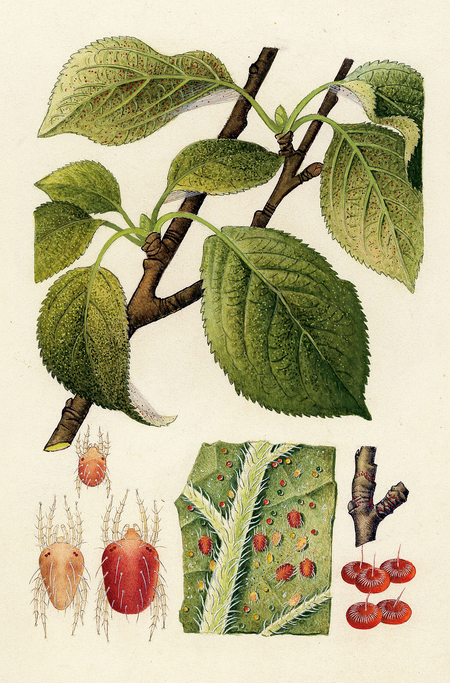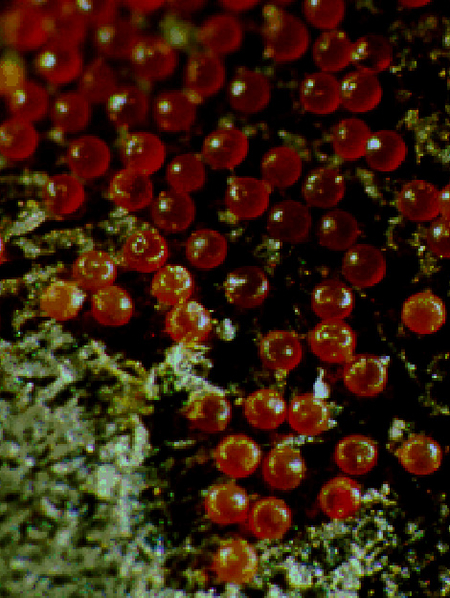European red mite
Panonychus ulmi
Appearance
The fruit tree spider mites belong to the group of spider mites (Tetranychidae). They are approx. 0.5 to 0.6 mm in size, crimson, have a plump body shape and have four pairs of legs.
The eggs are onion-shaped, red in colour and have a radial striation on the surface, which unites at the top to form a small hairy process.



Biology
The fruit tree spider mites live mainly on the underside of leaves of fruit and vine trees.
In spring, depending on weather conditions from mid-April, the larvae hatch from the winter eggs and within three to four weeks develop into males and females, which lay eggs shortly afterwards (summer eggs). Summer eggs are shaped like winter eggs and are also frequently laid on fruit in midsummer. In favorable weather, rapid development and heavy reproduction of fruit tree spider mites occurs in just a few weeks.
Within one vegetation period there are about four to five generations. The intensity of spider mite emergence during the growing season is largely determined by weather conditions: dry-warm weather accelerates development, wet-cold weather slows down life processes.
The overwintering of the fruit tree spider mite takes place in the egg stage (red winter eggs). At the time of dormancy, the eggs are often found in large numbers near the buds, on the fruit wood, in branch forks and on the undersides of twigs.
Damage symptoms
Due to the sucking activity of the fruit tree spider mites, lightening or light speckling and spots appear on the leaves from spring onwards. These first appear near the leaf veins and later spread over the entire leaf. The leaves acquire a pale yellow appearance. The adult mites, larvae and eggs can be seen on the underside of the leaf, and in case of heavy infestation there is a tangle of delicate spider threads on it. The infested leaves dry out and fall off prematurely.
In winter, the conspicuously red-colored, round winter eggs of the fruit tree spider mites are found especially on the undersides of the branches, where they are deposited in groups, preferably at bark cracks. When eggs are laid heavily, whole sections of twigs are colored red.
Prevention and control
- Avoidance of excessive nitrogen fertilization
- Protection and promotion of natural enemies, especially predatory mites (e.g. planting hedges, constant pollen supply)
- Establishment of predatory mites (e.g. Typhlodromus pyri)
- Application of winter and budburst sprays (see list of plant protection products approved in Austria) to control the overwintering eggs of the fruit tree spider mite during dormancy or budburst. Here, care must be taken to ensure thorough wetting of all parts of the crown.
- During the growing season, spider mites can be treated with specific acaricides (see list of plant protection products approved in Austria) if the damage threshold is exceeded (e.g. apple: in early summer more than five spider mites per leaf, towards the end of summer a higher spider mite population can be tolerated).
- Caution: If an active ingredient is used too often in succession against spider mites, resistance can develop quickly! Therefore, avoid the development of resistance by changing the active ingredient.
Last updated: 21.03.2025
automatically translated